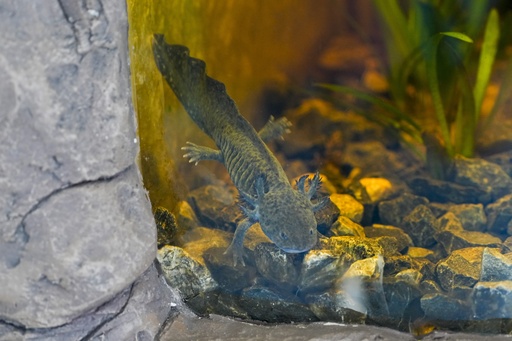MEXICO CITY — According to legend, the axolotl was not always the amphibian that we know today. Once considered a mischievous deity, it has evolved into Mexico’s most cherished salamander, and efforts to preserve its existence have intensified.
Yanet Cruz, the director of the Chinampaxóchitl Museum in Mexico City, shared, “It’s a fascinating little creature.” The museum focuses on the axolotl and chinampas, the ancient agricultural systems resembling floating gardens that are still active in Xochimilco, a notable area of canals located on the periphery of Mexico City. Cruz emphasized, “Although there are many types, the axolotl from this region is a vital symbol for the indigenous people,” reflecting on activities held in early February to coincide with “Axolotl Day.”
While there are no formal estimates of how many axolotls remain today, the species known as Ambystoma mexicanum is categorized as “critically endangered” by the IUCN Red List of Threatened Species, a status it has held since 2019. Despite the concerted efforts of biologists, historians, and officials to save the axolotl and its habitat from demise, a surprising rise in public interest has emerged.
Popularity for the axolotl surged internationally after its introduction in the video game Minecraft in 2021, further fueled by the Central Bank’s decision to feature the axolotl on the new 50-peso bill. “That marked the peak of ‘axolotlmania’,” noted Cruz.
Today, the unique, dragon-like creature adorns murals, crafts, and even socks across Mexico. Bakeries are creating buzz with axolotl-themed treats, and a local brewery has even adopted the name “Ajolote” in homage to this iconic amphibian, showcasing its significance in Mexican culture.
Historically, the axolotl may have lacked the archaeological representation enjoyed by figures like Tláloc, the Aztec rain god, or Coyolxauhqui, the moon goddess, prior to the Spanish conquest of Mexico-Tenochtitlan in the 16th century. However, it did appear in ancient Mesoamerican texts.
Within the Nahua myth concerning the Fifth Sun, the deity Nanahuatzin sacrificed himself by jumping into a fire, emerging as the sun and instructing other gods to follow his example to enact change in the world. All complied, except for Xólotl, a god associated with the evening star, who fled. “He was ultimately pursued and killed,” explained Arturo Montero, an archaeologist with the National Commission of Protected Natural Areas. “From his demise emerged a new creature: the axolotl.”
Montero interprets this myth as signifying that when a god perishes, its essence becomes encased within a common creature, which then experiences the natural cycles of life. Therefore, the axolotl is believed to hold the spirit of the deity Xólotl, and as the axolotl transitions to the underworld upon death, it is said to reemerge, allowing for the birth of another axolotl.
“Axolotl is akin to maize, agave, and water,” added Montero, revealing the creature’s deep-rooted connections to Mexican culture. The present fascination with the axolotl, alongside the recognition of its sacred status in pre-Hispanic times, is attributed to its remarkable biological characteristics.
In captivity, axolotls can be difficult to spot within fish tanks due to their usually dark skin that mimics stones, although breeders do produce a pink, albino variety. They possess the unique ability to remain motionless for extended periods, either submerged in mud or lying at the bottom of tanks. Remarkably, they breathe through their gills and skin—adaptations that suit their aquatic environments and contribute to their astonishing regenerative capabilities, allowing them to repair portions of their hearts, spinal cords, and even brains.
“This species is truly unusual,” remarked biologist Arturo Vergara, who oversees axolotl conservation at various institutions and manages specimens available for sale at a hatchery in Mexico City. At Ambystomania, where Vergara is employed, axolotls range in price depending on color and size, starting at around 200 pesos (approximately $10). Once they reach four inches in length, they become viable companion pets, and Vergara shared that while they typically have a lifespan of 15 years in captivity, some have lived up to 20 years. “They are quite long-lived, although they might only survive three or four years in the wild,” he noted.
The axolotls at the museum represent one of 17 distinct varieties found in Mexico and are native to increasingly polluted lakes and canals. A healthy axolotl population would likely face challenges in terms of nourishment and reproduction. Vergara explained the situation: “Just picture the bottom of a canal in areas like Xochimilco, Tlahuac, and Chalco, laden with countless microbes.”
In ideal conditions, the axolotl could recover from bites inflicted by snakes or herons and survive the dry season buried in mud, but it requires a suitable aquatic habitat to thrive. Cruz stated, “Preservation efforts for the axolotl must align with the conservation of chinampas.” These formations are essential not only as spawning grounds for axolotls but also as historical locations where pre-Hispanic people cultivated maize, chili, beans, and zucchini. Today, some residents of Xochimilco continue to grow vegetables in these areas, despite numerous environmental threats.
“Many chinampas have become dry and have ceased to produce food,” Cruz lamented. “Some areas that used to feature chinampas are now home to soccer fields.”
For both Cruz and Vergara, saving the axolotl is more than just a biological endeavor; it’s about preserving the habitat that nurtures this unique species. “This extensive system of chinampas is the last remnant of the lake city of Mexico-Tenochtitlan, so I constantly remind our visitors that Xochimilco is a living archaeological site,” said Cruz. “If we fail to care for what belongs to us, we will eventually lose it.”




